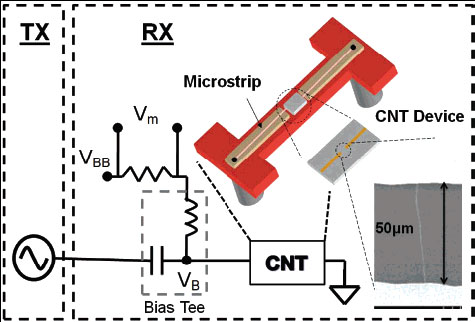| Posted: Oct 29, 2007 | |
And you thought the iPod nano was small - here comes nanotechnology radio |
|
| (Nanowerk Spotlight) We have written plenty of Spotlights so far on carbon nanotubes and nanoelectronics. For instance, carbon nanotube (CNT) transistors have the potential to outperform state-of-the-art silicon devices. Researchers around the world have been working for years on advances at the device level, things like switches and wires and optimizing individual CNT transistors. More recently, scientists have begun to integrate nanotechnology-based materials and devices into larger systems - a crucial step in getting nanotechnology from the lab to the fab. | |
| Last year, for instance IBM reported to have built the first complete electronic integrated circuit around a single carbon nanotube (An integrated logic circuit assembled on a single carbon nanotube). Researchers in California have now reported another step towards showing nanoelectronics in systems: They have developed the world's first working radio system that receives radio waves wirelessly and converts them to sound signals through a nano-sized detector made of CNTs. | |
| Although this is only the demonstration of a single critical component (the CNT as demodulator) of an entire radio system, it is entirely possible that at some point in the future all components of a working radio could be nanoscale, thus allowing a truly nanoscale wireless communications system (apart from the magnitude of the technological achievement, this is probably great news for surveillance freaks, not so much for privacy advocates). | |
| Peter Burke and Chris Rutherglen at the University of California, Irvine developed a CNT demodulator (a device that converts the radio frequency signal from the carrier into baseband signals such as video, audio, or data for further processing or amplification) that is capable of translating AM (amplitude modulation) radio waves into sound. In a laboratory demonstration, the researchers incorporated the detector into a complete radio system and used it to successfully transmit classical music wirelessly from an iPod to a speaker several feet away from the music player. | |
| In this setup, the carbon nanotube functions in the critical role as the receiver's AM demodulator. | |
| Burke, an Associate Professor in Electrical Engineering and Computer Science and leader of the UCI Nanotechnology Group, and Ruthergle, a grad student in Burke's group, reported their findings in the October 17, 2007 web edition of Nano Letters ("Carbon Nanotube Radio"). | |
| "Our CNT-based amplitude-modulated demodulator is effective at detecting the modulation signal up to 100 kHz" Burke tells Nanowerk. "We also successfully demonstrated our demodulator in an actual AM radio receiver operating at a carrier frequency of 1 GHz and capable of demodulating high-fidelity audio." | |
 |
|
| Schematic of the test-setup for the CNT-based AM demodulator. SEM image of a CNT (right). (Reprinted with permission from American Chemical Society) | |
| Burke explains that the transmitter portion of the demo utilizes a signal generator to create a 1 GHz RF signal that is externally amplitude modulated with music by an IPod and fed to a dipole antenna for wireless broadcast. | |
| "On the receiver side, the RX antenna picks up the RF signal, feeding it though a bias-tee and onto the carbon nanotubes where it is rectified" Burke says. "The distance between the TX and RX antennas was limited to approximately 1 meter, but that can be improved by simply including a standard front-end preamplifier to boost the received signal before sending it on to the CNT for demodulation." | |
| Burke and Rutherglen used a 1.5 V battery to properly bias the CNT for maximum demodulation. A differential pre-amplifier then amplifies the voltage drop across a sense resistor, and the high-fidelity audio is fed to a speaker for audio broadcast. | |
| "The audio-quality of the signal demodulated by the CNT was very clear and indistinguishable to the human ear from listening to the music directly" says Burke. | |
| He notes that they found the effectiveness of the modulation signal to be limited by by extrinsic parameters of the experimental setup and not due to the CNT itself. | |
| Hang on to your iPod, though. Burke says that there remain significant hurdles that need to be overcome before this technology can be scaled up and manufactured on a commercial scale. | |
 By
Michael
Berger
– Michael is author of three books by the Royal Society of Chemistry:
Nano-Society: Pushing the Boundaries of Technology,
Nanotechnology: The Future is Tiny, and
Nanoengineering: The Skills and Tools Making Technology Invisible
Copyright ©
Nanowerk LLC
By
Michael
Berger
– Michael is author of three books by the Royal Society of Chemistry:
Nano-Society: Pushing the Boundaries of Technology,
Nanotechnology: The Future is Tiny, and
Nanoengineering: The Skills and Tools Making Technology Invisible
Copyright ©
Nanowerk LLC
|
|
|
Become a Spotlight guest author! Join our large and growing group of guest contributors. Have you just published a scientific paper or have other exciting developments to share with the nanotechnology community? Here is how to publish on nanowerk.com. |
|
